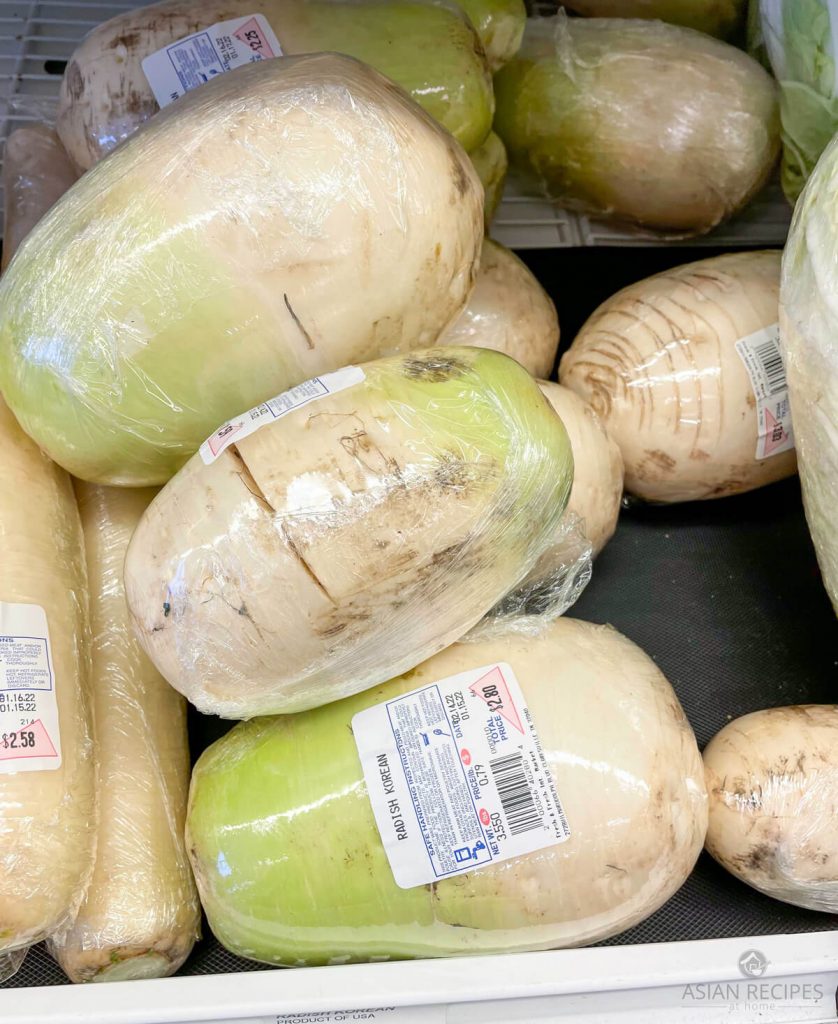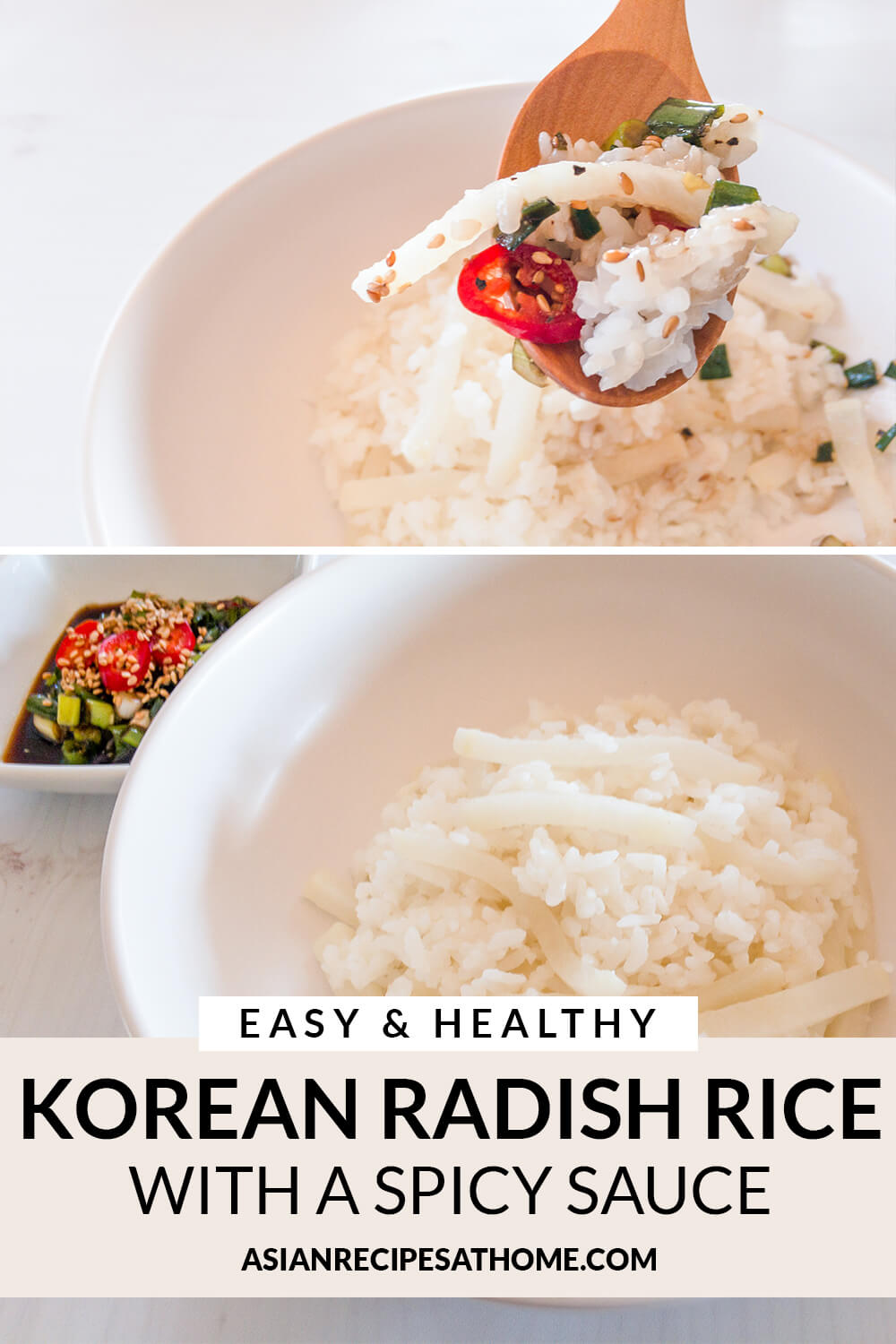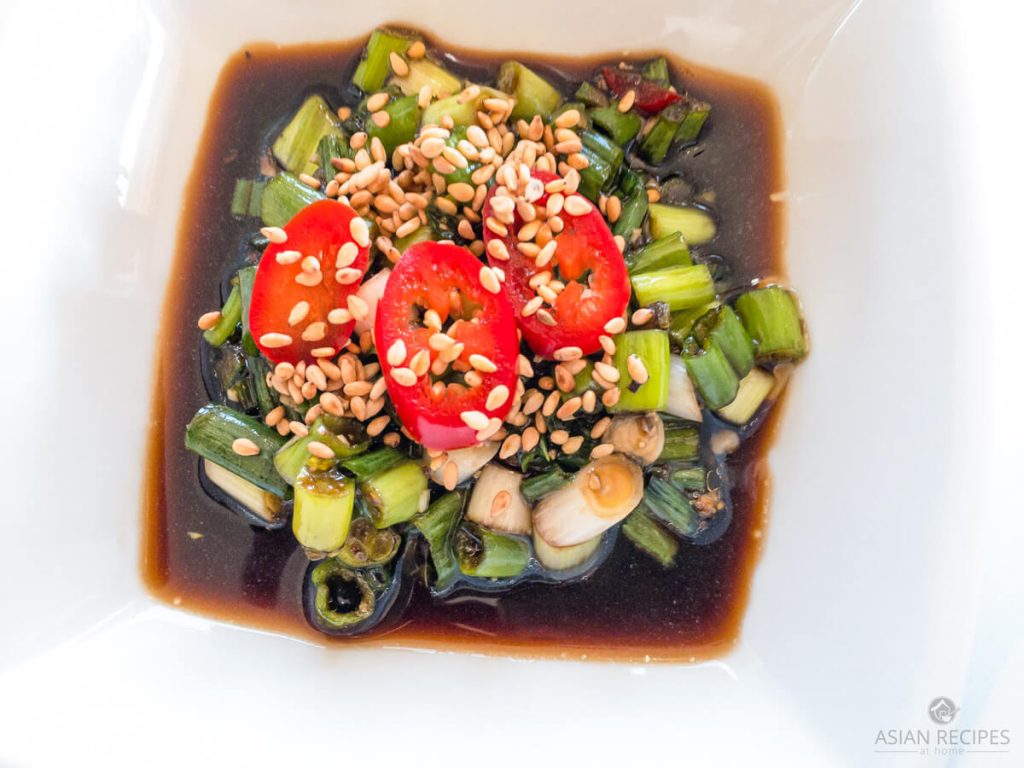This Korean radish rice recipe is a healthy one-pot dinner that is simple and delicious. We serve this rice with our homemade spicy sauce that is full of Asian flavors. With little effort, this recipe makes a healthy one-pot meal that is also nutritious.
Our easy Korean radish rice recipe
We love this recipe because of the simplicity and how easy it is. It is truly a one-pot meal that is also very healthy for you and your family. The rice and radish themselves are very mild in flavors together, however, the homemade sauce is where the kick of flavor is. The best part about the homemade sauce is you can adjust the spice level or make it without any of the spicy elements and it will still taste delicious!
Ingredients needed for this one-pot rice recipe
- Korean radish
- Sesame oil
- Salt
- White rice
- Water
For the sauce:
- Jalapeno pepper
- Green onions
- Garlic
- Sesame oil
- Roasted sesame seeds
- Soy sauce
- Fish sauce
- Korean red chili pepper powder (gochugaru), optional
- Ground black pepper
What is Korean radish (mu)
The tops of Korean radish are pale green and fade to a cream color. It’s a Daikon radish variation, but it’s shorter, thicker, and heavier, with firmer flesh and smoother leaves. Late autumn is the peak season for the Korean radish and is the best time to enjoy them. However, with modern farming techniques, you can find these radishes year-round in most Asian/Korean grocery stores.
The flavor of raw Korean radish is peppery with a touch of sweetness. The sweetness of the radish usually outweighs the bitterness in a good quality radish. It may be eaten raw or cooked. The spicy flavor is diminished when cooked.

Where to find Korean radish? Or grow them in your garden!
Look for Korean radishes at your local Asian/Korean grocery stores. You can find them at any time of year since it is a staple ingredient in a lot of Korean cooking, like in the staple kimchi.
If you don’t have access to a local grocery store that carries this radish, then consider trying to grow them yourself in your own garden. Here are some seeds we found online.
How to store Korean radish
If stored properly, fresh Korean radishes can last up to two months. Radishes, like potatoes, can develop shoots or rot if they are exposed to moisture. Keep the radish wrapped in newspaper paper or a paper towel in a cool, dry place. The optimal temperature is approximately 41˚F, or 5˚C. They can also last a long time in the fridge as well.
More recipes using Korean radish
- Spicy Braised Mackerel and Radish (Godeungeo Jorim)
- Spicy Korean Radish Kimchi
- Korean Radish Soup (Muguk)
HUNGRY FOR MORE? Subscribe to our newsletter and follow along on Facebook, Pinterest, Twitter, and Instagram for all of the latest updates.

Korean Radish Rice
This Korean radish rice recipe is a healthy one-pot dinner that is simple and delicious. We serve this rice with our homemade spicy sauce that is full of Asian flavors. With little effort, this recipe makes a healthy one-pot meal that is also nutritious.
Ingredients
- 2 cups Korean radishes, julienned (about ¼” thickness)
- 3 Tablespoons sesame oil
- 2 teaspoons salt
- 2 cups white rice
- 1 cup water
For the sauce:
- 1 jalapeno pepper
- 3 green onions
- 1 garlic clove, minced
- 1 Tablespoon sesame oil
- 1 ½ teaspoons roasted sesame seeds
- 3 Tablespoons soy sauce* See Notes for gluten-free
- 1 teaspoon fish sauce* See Notes for gluten-free
- 2 teaspoons Korean red chili pepper powder (gochugaru), optional
- ¼ teaspoon ground black pepper
Instructions
- Rinse the white rice really well. You may need to rinse and drain several times until the water runs clear. Soak the rice in cool water for about 5 hours. After 5 hours, drain the rice. Set aside.
- Let’s mix the sauce in a small bowl by mixing all of the ingredients for the sauce together. Set it aside for later.
- Place a pot on medium-high heat and add the sesame oil. Once hot, add in the radishes and salt. Stir-fry for about 10 minutes.
- Add the drained rice to the pot on top of the cooked radishes. You want the radishes to stay on the bottom. Add 1 cup of cold water to the pot. Turn the heat to medium-high heat and add the lid to the pot. Leave the lid cracked a little and let it cook for about 20 minutes.
- After 20 minutes, mix it up. Turn the heat down to low and let it continue to cook for about 10 minutes. Cover the pot with the lid and don’t leave it cracked for these 10 minutes.
- Rice should be completely cooked at this point, if so, then remove from heat and enjoy! If the rice isn’t completely cooked yet, then recover the pot with the lid and continue to let it cook on low in 5-minute increments until done. Remove from heat and enjoy! Don’t forget to enjoy this rice with the homemade sauce made in an earlier step!
Notes
*For gluten-free, substitute the soy sauce with a gluten-free Tamari sauce. Also, make sure the fish sauce of your choice is labeled gluten-free.
We love seeing your creations from our recipes! Tag us on Instagram at @AsianRecipesAtHome.
Disclaimer: Under no circumstances shall this website and the author(s) be responsible for any loss or damages resulting from the reliance of the given nutritional information or ingredient/product recommendations. Recommended ingredients/products can change their formula at any time without this website and author’s awareness. It is your responsibility (the reader’s) to check the label/ingredients of any product prior to purchasing and/or using. We greatly appreciate your support and understanding.



